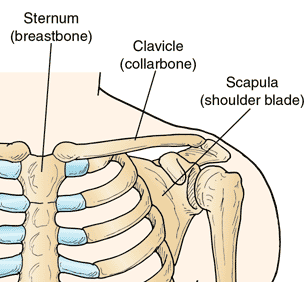clavicle

The clavicle, also known as the collarbone, is a thin, slightly S-shaped bone attached by ligaments to the top of the sternum (breastbone). The clavicle is present in most vertebrates. In humans, the right and left clavicles and right and left scapulas (shoulder blades) make up the shoulder girdle, linking the arms to the axis of the body. In birds the two collarbones are joined to form the furcula or wishbone.
The clavicle lies horizontally and articulates with the sternum and first costal cartilage medially and with the acromion of the scapula laterally. The clavicle acts as a strut holding the arm away from the trunk. It also serves to transmit forces from the upper limb to the axial skeleton, and provides attachment for muscles. The clavicle is subcutaneous throughout its length; its medial two-thirds are convex forward and its lateral third concave forward.
Broken collarbones
The ligaments that link each clavicle to the sternum and scapula are very strong, which explains why the clavicle is rarely dislocated but often broken. In fact the clavicle is the most commonly fractured bone in the body. Most fractures occur as a result of a fall on to the shoulder or an outstretched arm. The force is transmitted along the clavicle, which breaks at its weakest point – the junction of the middle and outer thirds. Following the fracture, the lateral fragment is depressed by the weight of the arm, and it is pulled medially and forward by the strong adductor muscles of the shoulder joint, especially the pectoralis major. The medial end is tilted upward by the sternomastoid muscles.
Because, when the clavicle is broken, the arm tends to sag it must be supported by a sling and a figure-of-eight bandage to keep the broken ends of the clavicle together until the fracture has healed. Healing is fast and usually complete within three weeks.
The close relationship of the supraclavicular nerves to the clavicle may result in their involvement in callus formation following fracture of the bone. This may be the cause of persistent pain over the side of the neck.
Ossification of the clavicle
The clavicle starts its ossification in membrane early in intrauterine life. A secondary center appears at the sternal end in the 20th year, and this fuses with the shaft by about the 25th year. The epiphyseal plate that remains within the shaft of the bone until the 25th year should not be confused with a fracture line.


